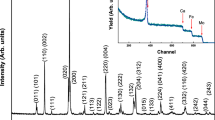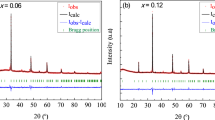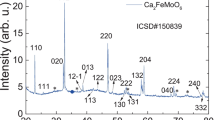Abstract
We report the magnetism properties on single crystal of Ca2FeMoO6 double perovskite prepared by a floating zone technique. This high quality material has been studied by X-ray powder diffraction (XRD), and magnetic measurements. The field dependence of the magnetization at 5 K, 100 K, and 300 K suggest a ferrimagnetic behavior with a saturation magnetic moment of approximately 2.1 μB, 2.0 μB, and 1.4 μB per formula unit, respectively. From dc susceptibility, we observed two magnetic transitions at T C1=380 K (paramagnetic–ferrimagnetic) and T C1=336 K (orthorhombic–monoclinic phase).
Similar content being viewed by others
Avoid common mistakes on your manuscript.
1 Introduction
In the 1990s, materials exhibiting colossal magnetoresistance (CMR) were widely studied due to technological interest [1]. The first compounds exhibiting CMR were manganese-oxides based on LaMnO3 perovskites. A few years later, some members of the family of double perovskite of composition A2MTO6 (A=alkali earths, M, T=transition metals) were proposed as half-metallic ferromagnets, as an alternative for perovskite manganites [2, 3]. We focused our attention on the Ca analogue of the A2FeMoO6 family. Polycrystalline Ca2FeMoO6 is a double perovskite that exhibits increase of magnetoresistance from 16.7 % to 44.2 % between 4 K and 300 K at a magnetic field of 7 Tesla. This increase is larger than that of Sr2FeMoO6 (T C=420 K) at the same corresponding extreme temperatures and applied magnetic field [4]. This makes Ca2FeMoO6 attractive enough for immediate colossal magnetoresistance-related applications, and availability of their single crystals is not only useful but convenient to better study their magnetotransport properties [6–8].
Neutron powder diffraction (NPD) study on a polycrystalline sample of Ca2FeMoO6 reveal that its magnetic structure can be described as a ferrimagnetic arrangement of Fe and Mo moments lying in the bc plane, approximately along the [110] direction [5].
In this work, we report the growth of high-quality single crystals of Ca2FeMoO6 using a floating zone technique method and its magnetic characterization by magnetization measurements as a function of temperature and applied magnetic field.
2 Experimental Details
X-ray powder diffraction (XRD) patterns were obtained in a Rigaku diffractometer at room temperature. The magnetization measurements were performed in a Quantum Design superconducting quantum interference device (SQUID) MPMS-7T dc-magnetometer.
Ca2FeMoO6 perovskite has been prepared in single crystalline form by using the laser heated pedestal growth method (LHPG) as described elsewhere [9]. The crystals were grown in isostatic inert atmosphere (ultrapure N2) at a specific pressure range (0.25–0.50 atm), using unreacted starting reagents. Laue X-ray diffraction (LXRD) photographies in the back-reflection mode were used to evaluate the crystalline quality and growth direction of each crystal.
3 Results
The obtained fibers are single crystals with black surfaces and were not detected inclusions of other phases in their volume or surface. The fibers have a diameter around 1 mm and are up to 40 mm long. The quality of the crystals was confirmed by Laue in the back-reflection mode and rocking curves performed along the fiber axis.
X-ray powder diffraction data obtained from crushed crystals were refined by the Rietveld method for phase identification and fitting of structural parameters. The crystal structure determined by X-ray diffraction is monoclinic, space group P21/n, with unit cell parameter a=5.41(1) Å, b=5.52(1) Å, c=7.71(2) Å, and β=89.9(8)∘ and are in good agreement with the results reported by Alonso et al. [3]. The crystal contains alternating FeO6 and MoO6 octahedral, considerably tilted due to the relatively small size of the Ca2+ cations. The crystal growth direction obtained from Laue photograph is [110].
Figure 1 shows the dc magnetic susceptibility χ as a function of the temperature for an applied magnetic field of 1 kOe parallel and perpendicular to the crystal growth axis [110]. The Curie temperature is 380 K and is indicated in Fig. 1 with an arrow; this value is in agreement with the obtained by others authors in polycrystalline sample [10]. At 20 K magnetic susceptibility with the field perpendicular to crystal growth direction decreases, while along [110] increase until the lowest temperature of 2 K.
The dc susceptibility reveals two peaks at T C1 and T C2, respectively, which shows that in the sample there are two magnetic transitions. The first magnetic transition corresponds to a paramagnetic–ferrimagnetic transition at T C1=380 K, which is close to the magnetic transition temperature (T C=377 K) reported in [6, 10]. This magnetic transition corresponds to the orthorhombic structure phase with space group Pbnm. The second magnetic transition at T C2=336.4 K emerges slightly below the magnetic transition temperature and could be associated to the monoclinic structure phase, as reported by Borges et al. in monoclinic Ca2FeMoO6 samples [6].
In the paramagnetic state, the inverse susceptibility was fitted to the Curie–Weiss law. We find the effective moment μeff=5.4 μB/f.u. and the Curie temperature θ=398 K for both magnetic field applied parallel and in perpendicular direction [110]. The effective moments are somewhat smaller than the theoretical Fe3+ free ion value of μeff=5.9 μB/Fe3+.
The magnetization versus magnetic field curves M(H) is shown in Fig. 2. Data have been collected by first cooling the sample in the 70 kOe field from 300 K directly to 5 K. The same procedure was repeated until 100 K and 300 K, respectively. The field dependence of magnetization with the magnetic field at 5 K, 100 K, and 300 K are typical of a ferrimagnetic material with a saturation magnetic moment of approximately 2.1 μB, 2.0 μB, and 1.4 μB per formula unit, respectively. There are not great differences between M vs. H curves when the magnetic field is applied in both directions. A similar behavior is also observed in the χ(T) (Fig. 1). Hence, we conclude that there is no magnetic anisotropy in the crystal growth direction [110].
As expected, the magnetization saturates, at rather low fields, at a value of about ≈3.5 μB. This value is smaller than that expected (4 μB, S total=5/2–1/2) for samples with strictly zero antisites defects. The low saturation magnetization observed, was explained in terms of the antisite defects at the B Fe and B Mo sites. For instance, if a Mo5+ (S=1/2) is at the B Fe site surrounded by the Mo5+ neighbors, its magnetic moment tends to be parallel to those of the Mo5+ ions, which decreases the net magnetization by 6 μB. In contrary manner, if a Fe3+ (S=5/2) is at a B Mo site, its magnetic moment tends to be antiparallel to those of the Fe3+ ions, causing a decrease in the net magnetization by 4 μB [5].
This reduction in the magnetic moment was also noticed the curves of χ(T) in Fig. 1. Coercivity field is typically as low as 30 Oe. The ideal ferrimagnetic configuration 3d5↑ 4d1↓ would yield a magnetic moment of 4.0 μB/unit formula. Our data seems to point out that ferrimagnetic Fe ion gives rise to some non-collinearity in the spin structure. Magnetism indicate a large component of itinerancy for down-spin Fe t2g electrons.
4 Conclusions
In summary, we report the growth of Ca2FeMoO6 double perovskite single crystals by the laser heated pedestal growth method technique. Ca2FeMoO6 single crystal exhibits magnetic properties typical of ferrimagnetic materials. Our data seems to point out that ferrimagnetic Fe ion gives rise to some non-collinearity in the spin structure. The size and crystal quality of the studied samples were adequate for full characterization.
References
Salomon, M.B., Jaime, M.: Rev. Mod. Phys. 73, 1 (2001)
Kobayashi, K.-I., Kimura, T., Sawada, H., Terakura, K., Tokura, Y.: Nature 395, 677 (1998)
Maignan, A., Raveau, B., Martin, C., Hervieu, M.: J. Solid State Chem. 144, 224 (1999)
Sarma, D.D., Sampathkumaran, E.V., Ray, S., Nagarajan, R., Majumbar, S., Kumar, A., Nalini, G., Guru Row, T.N.: Solid State Commun. 114, 465 (2000)
Alonso, J.A., Casais, M.T., Martínez-Lopes, M.J., Martínez, J.L., Velasco, P., Muñoz, A., Fernández-Díaz, M.T.: Chem. Mater. 12, 161 (2000)
Borges, R.P., Thomas, R.M., Cullinan, C., Coey, J.M.D., Suryanarayanan, R., BenDor, L., Pinsard-Gaudart, L., Revcolevschi, A.: J. Phys. Condens. Matter 11, L445 (1999)
Perry, A.S., Mcintyre, N.S.: J. Phys. Chem. 97, 11020 (1993)
Ritter, C., Ibarra, M.R., Morellon, L., Blasco, J., García, J., de Teresa, J.M.: J. Phys. Condens. Matter 12, 8295 (2000)
Barbosa, L.B., Reyes Ardila, D., Andreeta, J.P.: J. Cryst. Growth 254, 378 (2003)
Dai, J.M., Song, W.H., Wang, S.G., Ye, S.L., Wang, K.Y., Du, J.J., Sun, Y.P., Fang, J., Chen, J.L., Gao, B.J.: Mater. Sci. Eng. B 83, 217 (2001)
Acknowledgements
The authors wish to thank the Brazilian funding agencies CNPq, CAPES, and FAPITEC/SE for financial support.
Author information
Authors and Affiliations
Corresponding author
Rights and permissions
About this article
Cite this article
Moreno, N.O., Barbosa, L.B., Reyes Ardila, D. et al. Magnetic Measurements on Single Crystal of Double Perovskite Ca2FeMoO6 . J Supercond Nov Magn 26, 2501–2503 (2013). https://doi.org/10.1007/s10948-012-1723-x
Received:
Accepted:
Published:
Issue Date:
DOI: https://doi.org/10.1007/s10948-012-1723-x






